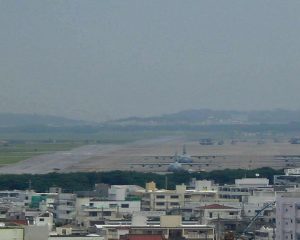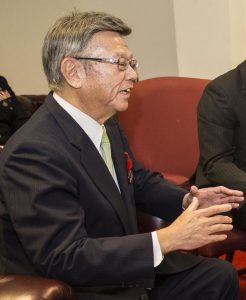Another rape and murder on Okinawa reignites long-simmering anti-US protests
On 19 May 2016, the body of a 20 year old local woman was found in a mountainous region in Okinawa. She had been throttled and stabbed.
She had gone missing on 28 April 2016 after telling her boyfriend she was going for a walk. It was reported that a US base worker—a former marine—had been detained on suspicion of disposing of her body. He was questioned and arrested after police found the woman’s corpse at a location he had provided.
Although the tragedy happened in the course of the woman’s everyday life, none of the circumstances were out of the ordinary.
The weekend after the suspect’s arrest, some 2,000 people rallied in silent protest outside Camp Zukeran, where the Okinawa Area Field Office of the US Forces Japan is located. Dressed in black-and-white clothes to mourn the woman’s death, the protestors demanded the removal of all US troops and bases from Okinawa.
History repeated
This is history repeated in Okinawa. Japan’s southernmost prefecture has, for a long time, been suffering crimes—including murder, robbery and rape—perpetrated by US military personnel and people associated with the US military. A local newspaper, Ryukyu Shimpo, reported on 20 May 2016 that there had been 574 cases between 1972 and 2015, with 741 US military officials and related civilians arrested over this period. The prime suspect in the recent rape and murder case was working at Kadena Air Base, a US military hub in Okinawa.
This latest incident has rekindled Okinawan memories of the 1995 kidnap and rape of a 12 year old schoolgirl by three young US servicemen, which sparked huge anti-US military rallies involving some eighty thousand people.
Triggered by the 1995 incident, the Japanese and US governments established the Special Action Committee on Facilities and Districts in Okinawa (SACO), which led to negotiations to reduce the US military presence in Japan. Apart from this, no major changes have occurred in relation to the presence of US bases on Okinawa in the 20 years since the outrage.
Okinawa has hosted US military bases since Japan’s defeat in the Second World War. In 2014, nearly 74 per cent of US military facilities in Japan designated for exclusive use by the US military were concentrated on the Okinawa Islands, which account for only 0.6 per cent of the entire Japanese territory.
The SACO-led discussions ended with the 2006 Roadmap which stipulated that the US Marine Corps’ Air Station Futenma would be returned to Japan on condition that Tokyo built an alternative facility. Henoko, which is adjacent to Camp Schwab, an existing US Marine Corps airbase, was proposed as the new site.

On a visit to Okinawa in August 2010, I observed Futenma Air Station from Kakazu Ridge, where a fierce battle took place during the Second World War. The airbase is dangerously located in the centre of Ginowan City, home to 90,000 people. I witnessed US military aircraft flying low over residential houses and even a primary school: consequently, the local people live with perpetual danger.
During this trip, I also visited Henoko and Takae which have become prominent sites for sit-in protests against US military troops and bases.
Henoko is a peaceful fishing village on Oura Bay, whose rich ecosystem is home to the dugong. Non-violent protests against the construction of a new military base which threatens the precious natural environment began in April 2004 and have now continued for over 4,000 days. Henoko is becoming a symbolic site in the contemporary Japanese social movement as the nation’s centre of peace activism.
Takae, a small village on the northern tip of Okinawa Island, also attracts attention. A ten-minute helicopter ride from Camp Schwab, the village is next to the Jungle Warfare Training Center, the only US military installation of its kind in the world. This is where US military personnel trained before being dispatched to fight in the Vietnam War in the 1960s.
‘The helicopters are so close we can see, from inside our homes, the faces of the American pilots when they take off from the existing helipads’
In the 2006 Roadmap, the US also promised to return half of the Jungle Warfare Training Center area to Okinawa on the condition that a replacement facility would be built in Henoko and six new helipads in Takae to enhance operations at the planned Henoko base.
However, Takae already hosts fifteen helipads. Here, again, people continue their sit-ins against the construction of the new helipads. The Takae residents are mostly farmers who are simply asking for a peaceful life. One resident told me, ‘The helicopters are so close we can see, from inside our homes, the faces of the American pilots when they take off from the existing helipads.’ Their simple wishes for a peaceful life will likely never be realised.
Discrimination
The deadlock demonstrates the incapability of both the Japanese and US governments to consolidate US bases on Okinawa. The proportion of bases sited in Okinawa represents a structural discrimination by the Japanese and US governments against the people of Okinawa. As of January 2016, the percentage of military facilities in Japan designated for exclusive use by the US military had been raised to nearly 75 per cent.

Okinawa’s governor Takeshi Onaga visited Tokyo on 23 May 2016 to meet with Prime Minister Shinzo Abe and Chief Cabinet Secretary Yoshihide Suga. Ryukyu Shimpo reported that the governor made a strong appeal concerning the recent rape incident by a military base employee, fighting back tears as he asked directly, ‘Do you not think that under the US–Japan Status of Forces Agreement, Japan’s independence is a myth?’
Onaga has been requesting the formal revision of the US–Japan Status of Forces Agreement, which was signed by the US and Japan in 1960 and governs the status of US forces stationed in Japan. Under the agreement, Japan has no right to exercise jurisdiction and hold legal proceedings involving US military personnel who allegedly commit a crime while on duty. Nor can Japanese police detain US military suspects until they are indicted.
However, both the US and Japanese governments are reluctant to formally revise the agreement because, it is claimed, suspects might return to the US while an investigation is in progress.
How long will Japan, as a sovereign state, allow this situation to continue? As long as it endures, sorrow and grief in Okinawa will also continue.
Featured image
Japanese people protesting against the Futenma Air Base in 2009. Photo: Wikimedia Commons
